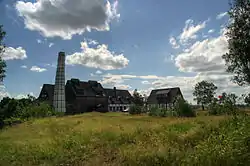Freiberg Mining Field
The Freiberg Mining Field (German: Freiberger Revier or Freiberger Bergbaurevier) is an ore field which, in its widest sense, is located on an ore deposit of precious and non-ferrous metals roughly 35 x 40 kilometres in area in the lower Eastern Ore Mountains in the German Free State of Saxony. The mining region is centred on Freiberg, but extends beyond that town's borough into the municipalities of Halsbrücke, Hilbersdorf, Bobritzsch, Weißenborn, Oberschöna and the boroughs of Brand-Erbisdorf and Großschirma. Mining has been carried out here since the last third of the 12th century. In a narrower sense the name refers to the area covered by the Freiburg and Halsbrück mining territories (Freiberger and Halsbrücker Grubenfelder). The Brand Mining Field (Brander Revier) immediately to the south comprises just the one mining territory, the Brander Grubenfeld.

Mining in the Freiberg area began here in the 12th century. This includes a steadily developed water supply system for the benefit of the mining industry, the Revierwasserlaufanstalt Freiberg.
The most important mineral deposits are the ores blue lead (galena), zincblende (sphalerite), fool's gold (pyrite), arsenical iron (arsenopyrite), argentiferous grey copper ore (freibergite), dark-red silver ores (Pyrargyrite), and silver glance. The most important non-metallic materials are: quartz, calcareous spar (calcite), heavy spar (baryte) and fluorspar (fluorite).[1]
Within this mining region there were, historically, a large number of smelteries and, even today, there are still various active smelting works, for example, in Muldenhütten.
References
- Otfried Wagenbreth, Eberhard Wächtler et al.: Der Freiberger Bergbau Technische Denkmale und Geschichte, 1st ed., Deutscher Verlag für Grundstoffindustrie Leipzig 1985, ISBN 3-342-00117-8.